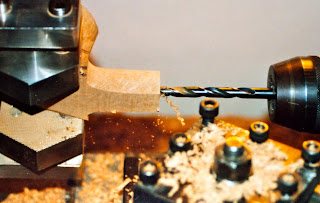Han går i gang med at grovslibe pibens facon ved bimsen og ser, hvad blokken ellers indeholder.
Den kan være fyldt med fejl, som kommer til syne ved første slibning, og der kan også være små sten i. Hvis det sker sendes der ikke milde tanker tilbage til træskæreren. Teddy plejer straks at lægge en sådan blok fra sig og måske vender han aldrig tilbage til den. Andre gange bliver der en sandblæst pibe ud af sådan en blok. I enkelte tilfælde kan det vise sig at fejlen ret hurtigt kan slibes væk, og så er pibemageren glad igen.
Den første fase i tilblivelsen af piben kan ske ved drejebænken. Først drejes hovedets form og tobakshul.
Derefter pibehalsen og taphullet, hvor spidsen skal sidde.
Til sidst bores røgkanalen ud.
Den kan godt være lidt besværlig, specielt hvis piben har en speciel facon. Det er vigtigt at røgkanalen ikke ligger for tæt på overfladen. Så kan der brændes hul i pibehalsen ved brug.
Now the pipemaker is back home with his blocks. The first thing, he does, is to study every block and find out which kind of pipe he sees in them. Is there a classic, a bulldog or a “freestyle” pipe hidden in the block? Which customers does he have, and what is happening on the market?
He starts by cutting the block roughly to the shape of the pipe at the BIMS. That way he can see what´s in the block.. It may be filled with spots that you can only see when you begin to work with it. Sometimes you can find small stones in the blocks and when you do so, you do not think kindly of your woodcutter. Usually Teddy puts a block like that away immediately and he might never work on it again, ever! Sometimes when the block has spots or faults, you can make a sandblast. And some times you just grind a little more at the spot, and it goes away for good. When that happens, you can hear the pipemaker whistle.
First step in pipemaking occurs at the lathe. First you make the shape of the pipehead and the tobacco hole. Then comes schank and the tenon hole for the mouthpiece. Finally you drill the flue. This is a bit tricky, especially if the shape of the pipe is special. It is important that the flue is not to close to the surface. It might cause a hole in the schank, when you smoke the pipe.





Ingen kommentarer:
Send en kommentar